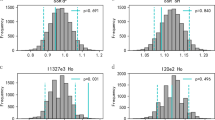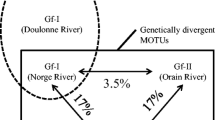Abstract
Theoretical and empirical studies suggest that an optimal resistance to pathogens and parasites requires an optimal number of MHC alleles per individual. Here we argue that three-spined sticklebacks (Gasterosteus aculeatus) achieve this goal by applying a strategy that involves a self-referential process. According to this model, females complement their own set of alleles with a more or less diverse set of male alleles such that the combined diversity reaches an optimum. In previous experiments, we have identified allele counting as a major mate-choice strategy in large populations. The self-referential allele-counting hypothesis predicts that MHC-based mate choice favors dissimilar MHC alleles in small populations facing the risk of inbreeding. Therefore, we conducted an experiment that simulated a small effective population size with low MHC class-II diversity. Our experiments are based on the analysis of MHC class-IIB alleles that explain a major part of the overall MHC diversity in sticklebacks, as determined by mathematical modeling. The results show that females preferred males with dissimilar alleles. Our present and the previous studies (which we reanalyzed with respect to our new predictions) show that irrespective of high or low population diversity faced by female sticklebacks for their mate choice, they use information about their own and their potential mate's MHC polymorphism for optimal complementation of their own set of alleles. From combining the data of the previous and the present experiment we found that female sticklebacks try to achieve an optimum number of MHC class-IIB alleles for their offspring through mate choice. The chosen MHC diversity is close to the most frequent diversity found naturally in individual fish, which in addition have the lowest parasite burden.



Similar content being viewed by others
References
Aeschlimann P, Häberli M, Milinski M (2000) Threat-sensitive feeding strategy of immature sticklebacks (Gasterosteus aculeatus) in response to recent experimental infection with the cestode Schistocephalus solidus. Behav Ecol Sociobiol 49:1–7
Apanius V, Penn D, Slev PR, Ruff LR, Potts WK (1997) The nature of selection on the major histocompatibility complex. Crit Rev Immunol 17:179–224
Bakker TCM, Milinski M (1991) Sequential female choice and the previous male effect in sticklebacks. Behav Ecol Sociobiol 29:205–210
Barber I, Arnott SA, Braithwaite VA, Andrew J, Huntingford FA (2001) Indirect fitness consequences of mate choice in sticklebacks: offspring of brighter males grow slowly but resist parasitic infections. Proc R Soc Lond B 268:71–76
Beauchamp GK, Yamazaki K, Bard J, Boyse EA (1988) Preweaning experience in the control of mating preferences by genes in the major histocompatibility complex of the mouse. Behav Genet 18:537–547
Binz T, Reusch TBH, Wedekind C, Milinski M (2001) SSCP analysis of Mhc class IIB genes in the threespine stickleback. J Fish Biol 58:887–890
Bjorkmann PJ, Parham P (1990) Structure, function, and diversity of class-I major histocompatibility complex-molecules. Annu Rev Biochem 59:253–288
Brown RE, Roser B, Singh PB (1989) Class I and class II regions of the major histocompatibility complex both contribute to individual odors in congenic inbred strains of rats. Behav Genet 19:659–674
Carter R, Schofield L, Mendis K (1992) HLA effects in malaria: increased parasite-killing immunity or reduced immunopathology. Parasitol Today 8:41–42
Couldridge VCK, Alexander GJ (2001) Does the time spent near a male predict female mate choice in a Malawian cichlid? J Fish Biol 59:667–672
De Boer RJ, Perelson AS (1993) How diverse should the immune system be? Proc R Soc Lond B 252:171–175
Doherty PC, Zinkernagel RM (1975) Enhanced immunological surveillance in mice hetereozygous at the H-2 gene complex. Nature 256:50–52
Dyall R, Messaoudi I, Janetzki S, Nikolic-Zugic J (2000) MHC polymorphism can enrich the T cell repertoire of the species by shifts in intrathymic selection. J Immunol 164:1695–1698
Edwards SV, Hedrick PW (1998) Evolution and ecology of MHC molecules: from genomics to sexual selection. Trends Ecol Evol 13:305–311
Hamilton WD, Zuk M (1982) Heritable true fitness and bright birds: a role for parasites? Science 218:384–387
Hedrick PW, Black FL (1997) HLA and mate selection: no evidence in South Amerindians. Am J Hum Genet 61:505–511
Hughes AL, Hughes MK (1995) Natural selection on the peptide-binding regions of major histocompatibility complex molecules. Immun Gen 42:233–243
Hughes AL, Nei M (1988) Patterns of nucleotide substitution at major histocompatibility complex class I loci reveal overdominant selection. Nature 335:167–170
Hughes AL, Yeager M (1998) Natural selection at major histocompatibility complex loci of vertebrates. Annu Rev Genet 32:415–435
Jacob S, McClintock MK, Zelano B, Ober C (2002) Paternally inherited HLA alleles are associated with women`s choice of male odor. Nat Genet 30:175–179
Klein J (1986) Natural history of the major histocompatibility complex. Wiley, New York
Landry C, Garant D, Duchesne P, Bernatchez L (2001) Good genes as heterozygosity: the major histocompatibility complex and mate choice in Atlantic salmon (Salmo salar). Proc R Soc Lond B 268:1279–1285
Laufer TM, DeKoning J, Markowitz JS, Lo D, Glimcher LH (1996) Unopposed positive selection and autoreactivity in mice expressing class II MHC only on thymic cortex. Nature 383:81–85
Málaga-Trillo E, Zaleska-Rutczynska Z, McAndrew B, Vincek V, Figueroa F, Sültmann H, Klein J (1998) Linkage relationships and haplotype polymorphism among cichlid Mhc class II B loci. Genetics 149:1527–1537
McLennan DA, McPhail JD (1990) Experimental investigations of the evolutionary significance of sexually dimorphic nuptial coloration in Gasterosteus aculeatus (L.): the relationship between male colour and female behaviour. Can J Zool 68:482–492
McPhail JD (1994) Speciation and the evolution of reproductive isolation in the stickleback (Gasterosteus) of south western British Columbia. In: Bell MA, Foster SA (eds) The evolutionary biology of the threespine stickleback. Oxford University Press, Oxford, pp 399–437
Meerwijk JPM van, Marguerat S, Lees RK, Germain RN, Fowlkes BJ, McDonald HR (1997) Quantitative impact of thymic clonal deletion on the T cell repertoire. J Exp Med 185:377–383
Milinski M, Bakker TCM (1990) Female sticklebacks use male coloration in mate choice and hence avoid parasitized males. Nature 344:330–333
Nowak MA, Tarczy-Hornoch K, Austyn JM (1992) The optimal number of major histocompatibility complex molecules in an individual. Proc Natl Acad Sci USA 89:10896–10899
Ober C, Weitkamp LR, Cox N, Cox H, Dytch H, Kostyu D, Elias S (1997) HLA and mate choice in humans. Am J Hum Genet 61:497–504
Olsén KH, Grahn M, Lohm J, Langefors A (1998) MHC and kin discrimination in juvenile Artic charr, Salvelinus alpinus (L.). Anim Behav 56:319–327
Paterson S, Pemberton JM (1997) No evidence for major histocompatibility complex-dependent mating patterns in a free-living ruminant population. Proc R Soc Lond B 264:1813–1819
Penn D, Potts W (1998) How do major histocompatibility complex genes influence odor and mating preferences? Adv Immunol 69:411–435
Penn DJ, Potts WK (1999) The evolution of mating preferences and major histocompatibility complex genes. Am Nat 153:145–164
Penn DJ, Damjanovich K, Potts WK (2002) MHC heterozygosity confers a selective advantage against multiple-strain infections. Proc Natl Acad Sci USA 99:11260–11264
Potts WK, Slev PR (1995) Pathogen-based models favoring MHC genetic diversity. Immun Rev 143:181–197
Potts WK, Manning CJ, Wakeland EK (1991) Mating patterns in seminatural populations of mice influenced by MHC genotype. Nature 352:619–621
Reusch TBH, Häberli MA, Aeschlimann PB, Milinski M (2001a) Female sticklebacks count alleles in a strategy of sexual selection explaining MHC polymorphism. Nature 414:300–302
Reusch TBH, Wegner KM, Kalbe M (2001b) Rapid genetic divergence in postglacial populations of threespine stickleback (Gasterosteus aculeatus): the role of habitat type, drainage and geographical proximity. Mol Ecol 10:2435–2445
Rundle HD, Nagel L, Boughman JW, Schluter D (2000) Natural selection and parallel speciation in sympatric sticklebacks. Science 287:306–308
Salazar M, Leong T, Tu N, Gelman RS, Watson ALM, Bronson R, Iglesias A, Mann M, Good RA, Yunis EJ (1995) Life-span, T-cell responses, and incidence of lymphomas in congenic mice. Proc Natl Acad Sci USA 92:3992–3996
Singer AG, Beauchamp GK, Yamazaki K (1997) Volatile signals of the major histocompatibility complex in male mouse urine. Proc Natl Acad Sci USA 94:2210–2214
Singh PB, Brown RE, Roser B (1987) MHC antigens in urine as olfactory recognition cues. Nature 327:161–164
Wedekind C, Füri S (1997) Body odour preferences in men and women: do they aim for specific MHC combinations or simply heterozygosity? Proc R Soc Lond B 264:1471–1479
Wedekind C, Seebeck T, Bettens F, Paepke AJ (1995) MHC-dependent mate preferences in humans. Proc R Soc Lond B 260:245–249
Wegner KM, Reusch TBH, Kalbe M (2003) Multiple parasites are driving major histocompatibility complex polymorphism in the wild. J Evol Biol 16:233–241
Yamazaki K, Boyse EA, Miké V, Thaler HT, Mathieson BJ, Abbott J, Boyse J, Zayas ZA, Thomas L (1976) Control of mating preferences in mice by genes in the major histocompatibility complex. J Exp Med 144:1324–1335
Yamazaki K, Beauchamp GK, Kupniewsky D, Bard J, Thomas L, Boyse EA (1988) Familial imprinting determines H-2 selective mating preferences. Science 240:1331–1332
Yamazaki K, Beauchamp GK, Shen F, Bard J, Boyse EA (1991) A distinctive change in odortype determined by H-2D-L mutation. Immun Gen 34:129–131
Yamazaki K, Beauchamp GK, Shen F-W, Bard J, Boyse EA (1994) Discrimination of odortypes determined by the major histocompatibility complex amnong outbred mice. Proc Natl Acad Sci USA 91:3735–3738
Acknowledgements
We thank S. Liedtke and C. Schmuck for laboratory assistance, H. Deiwick and D. Lemcke for technical support, and G. Augustin for maintaining the aquaria. K.M. Wegner and the referees gave valuable comments on the manuscript. P.A. and M.H. were supported by the Swiss National Fund. The experiments comply with the current laws of Germany.
Author information
Authors and Affiliations
Corresponding author
Additional information
Communicated by M. Abrahams
Rights and permissions
About this article
Cite this article
Aeschlimann, P.B., Häberli, M.A., Reusch, T.B.H. et al. Female sticklebacks Gasterosteus aculeatus use self-reference to optimize MHC allele number during mate selection. Behav Ecol Sociobiol 54, 119–126 (2003). https://doi.org/10.1007/s00265-003-0611-6
Received:
Revised:
Accepted:
Published:
Issue Date:
DOI: https://doi.org/10.1007/s00265-003-0611-6




